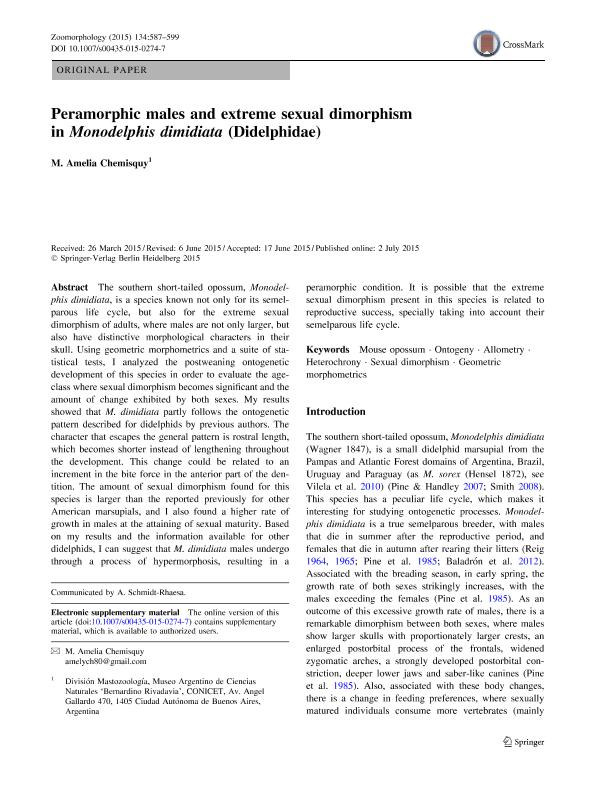Artículo
Peramorphic males and extreme sexual dimorphism in Monodelphis dimidiata (Didelphidae)
Fecha de publicación:
11/2015
Editorial:
Springer
Revista:
Zoomorphology (Berlin. Print)
ISSN:
0720-213X
Idioma:
Inglés
Tipo de recurso:
Artículo publicado
Clasificación temática:
Resumen
The southern short-tailed opossum, Monodelphisdimidiata, is a species known not only for its semelparouslife cycle, but also for the extreme sexualdimorphism of adults, where males are not only larger, butalso have distinctive morphological characters in theirskull. Using geometric morphometrics and a suite of statisticaltests, I analyzed the postweaning ontogeneticdevelopment of this species in order to evaluate the ageclasswhere sexual dimorphism becomes significant and theamount of change exhibited by both sexes. My resultsshowed that M. dimidiata partly follows the ontogeneticpattern described for didelphids by previous authors. Thecharacter that escapes the general pattern is rostral length,which becomes shorter instead of lengthening throughoutthe development. This change could be related to anincrement in the bite force in the anterior part of the dentition.The amount of sexual dimorphism found for thisspecies is larger than the reported previously for otherAmerican marsupials, and I also found a higher rate ofgrowth in males at the attaining of sexual maturity. Basedon my results and the information available for otherdidelphids, I can suggest that M. dimidiata males undergothrough a process of hypermorphosis, resulting in aperamorphic condition. It is possible that the extremesexual dimorphism present in this species is related toreproductive success, specially taking into account theirsemelparous life cycle.
Archivos asociados
Licencia
Identificadores
Colecciones
Articulos(CRILAR)
Articulos de CENTRO REGIONAL DE INV. CIENTIFICAS Y TRANSFERENCIA TECNOLOGICA DE ANILLACO
Articulos de CENTRO REGIONAL DE INV. CIENTIFICAS Y TRANSFERENCIA TECNOLOGICA DE ANILLACO
Citación
Chemisquy, Maria Amelia; Peramorphic males and extreme sexual dimorphism in Monodelphis dimidiata (Didelphidae); Springer; Zoomorphology (Berlin. Print); 134; 4; 11-2015; 587-599
Compartir
Altmétricas




